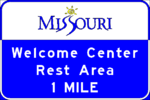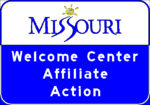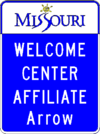903.10 General Service Signs: Difference between revisions
mNo edit summary |
m →903.10.1 Sizes of General Service Signs (MUTCD Section 2I.01): removed start date |
||
| (One intermediate revision by one other user not shown) | |||
| Line 5: | Line 5: | ||
'''Guidance.''' The districts should give advanced notice to the entity for which the sign was installed for before removing the signs at the end of their service life. Any General Service Sign which is in place that directs motorists to a location which is no longer providing the service should be removed immediately. | '''Guidance.''' The districts should give advanced notice to the entity for which the sign was installed for before removing the signs at the end of their service life. Any General Service Sign which is in place that directs motorists to a location which is no longer providing the service should be removed immediately. | ||
'''Support.''' General Service Signing was the motorist service signing system before the adoption of the [ | '''Support.''' General Service Signing was the motorist service signing system before the adoption of the [https://epg.modot.org/index.php?title=903.9_Specific_Service_Signs#903.11.3_Logos_and_Logo_Sign_Panels_.28MUTCD_Section_2J.03.29 Logo program] in 1991. The Logo program has become the recognized system nationally for directing motorist to the services they wish to find, making the General Service Signing system redundant and not widely used by motorist. This is the reason the program has been eliminated. | ||
General Service Signing for Alternate Fuels will be incorporated into the next TODS and Logo contract to supplement these programs and help direct motorist to available alternate fuels which may be available at normal fuel stations. Alternate fuels will include Blended Ethanol (E85), Biodiesel (B20), Compressed Natural Gas (CNG) and Propane | General Service Signing for Alternate Fuels will be incorporated into the next TODS and Logo contract to supplement these programs and help direct motorist to available alternate fuels which may be available at normal fuel stations. Alternate fuels will include Blended Ethanol (E85), Biodiesel (B20), Compressed Natural Gas (CNG) and Propane. | ||
==903.10.2 Rest Area and Other Roadside Area Signs (MUTCD Section 2I.05)== | ==903.10.2 Rest Area and Other Roadside Area Signs (MUTCD Section 2I.05)== | ||
Latest revision as of 09:58, 23 October 2023
903.10.1 Sizes of General Service Signs (MUTCD Section 2I.01)
Standard. General Service Signs have been discontinued. MoDOT shall no longer provide General Service Signs. General Service Signs shall be left in place until they reach the end of their service life.
Guidance. The districts should give advanced notice to the entity for which the sign was installed for before removing the signs at the end of their service life. Any General Service Sign which is in place that directs motorists to a location which is no longer providing the service should be removed immediately.
Support. General Service Signing was the motorist service signing system before the adoption of the Logo program in 1991. The Logo program has become the recognized system nationally for directing motorist to the services they wish to find, making the General Service Signing system redundant and not widely used by motorist. This is the reason the program has been eliminated. General Service Signing for Alternate Fuels will be incorporated into the next TODS and Logo contract to supplement these programs and help direct motorist to available alternate fuels which may be available at normal fuel stations. Alternate fuels will include Blended Ethanol (E85), Biodiesel (B20), Compressed Natural Gas (CNG) and Propane.
903.10.2 Rest Area and Other Roadside Area Signs (MUTCD Section 2I.05)
 |
 |
 |
 |
Standard. The appropriate roadside feature sign shall be erected in advance of state maintained roadside parks, historic marker, scenic view or roadside table. Any combination of these facilities is to be signed only for the facility appearing first in that order. If a table is provided at a historic marker or scenic view, the Table sign may be mounted below the Historic Marker or Scenic View sign.
Rest Area signs shall have a retroreflective white legend and border on a blue background.
Signs that include the legend REST AREA shall be used only where parking and restroom facilities are available.
Guidance. A roadside area that does not contain restroom facilities should be signed to indicate the major road user service that is provided. The sign legends for an area with only picnic tables and parking should use words such as PICNIC AREA, ROADSIDE TABLE or ROADSIDE PARK instead of REST AREA.
Rest areas that have tourist information and welcome centers should be signed as discussed in EPG 903.10.5.
Scenic area signing should be consistent with that provided for rest areas, except that the legends should use words such as SCENIC AREA, SCENIC VIEW or SCENIC OVERLOOK instead of REST AREA.
If a rest area or other roadside area is provided on a conventional road, a D5-1 sign should be installed in advance of the rest area or other roadside area to permit the driver to reduce speed in preparation for leaving the highway. A D5-2b sign should be installed at the turnoff point where the driver needs to leave the highway to access the rest area or other roadside area.
If a rest area or other roadside area is provided on a freeway or expressway, a D5-1 sign should be placed 1 mile and/or 2 miles in advance of the rest area.
Standard. A D5-2a sign shall be placed at the rest area or other roadside area exit gore.
Option. A D5-1a sign may be placed between the D5-1 sign and the exit gore on a freeway or expressway. A second D5-1 sign may be used with a distance to the nearest ½ or ¼ mile displayed as a fraction rather than a decimal for distances less than 1 mile.
To provide the road user with information on the location of succeeding rest areas, a NEXT REST AREA XX MILES (D5-6) sign may be installed independently or as a supplemental sign mounted below one of the REST AREA advance guide signs.
Standard. All signs on freeways and expressways for rest and other roadside areas shall have letter and numeral sizes that comply with the minimum requirements of Table 903.8.12. The sizes for General Service signs that have standardized designs shall be as shown in Table 903.10.1.
Option. If the rest area has facilities for the physically impaired, the International Symbol of Accessibility for the Handicapped (D9-6) sign may be placed with or beneath the REST AREA advance guide sign.
903.10.3 Tourist Information and Welcome Center Signs (MUTCD Section 2I.08)
 |
 |
 |
Standard. The Commission shall no longer provide service signing for tourist information centers either privately or publicly owned. The MISSOURI WELCOME CENTER AFFILIATE signs will be the only signing choice for Tourist Information Center requests. See EPG 903.10.6 Missouri Welcome Center Affiliates for additional information. Existing service signing for Tourist Information Centers shall be left in place until they reach the end of their service life.
Support. Tourist Information Centers operated only by the Missouri Division of Tourism are designated as Missouri Welcome Centers.
Guidance. Where Missouri Welcome Centers are located off state owned highways, Missouri Welcome Center (D5-11b) sign should be used.
Where Missouri Welcome Centers are located in rest areas the combination signs, Missouri Welcome Center / Rest Area (D5-9 and D5-10) sign, should be used in lieu of the rest area series of signing.
903.10.4 Missouri Welcome Center Affiliates
 |
 |
Support. The Missouri Division of Tourism has developed operational guidelines for Missouri Welcome Center Affiliates. This program is a means for local chamber/convention and visitor bureaus and institutions of higher education with an established tourism curriculum to promote tourism and increase the number of welcome centers in Missouri without expending state funds. Anyone interested in becoming a Missouri Welcome Center Affiliate should contact the Missouri Division of Tourism, email tourism@ded.mo.gov or call (573) 751-4133.
Standard. Upon written approval as a Missouri Welcome Center Affiliate by the Missouri Division of Tourism, the affiliate will request signing for the facility. The signing shall be paid for by the affiliate. A TR-15 contract shall be completed and payment received before ordering and installing the signs. The affiliates are recertified on a yearly basis, and if the affiliate fails to be recertified or losses the designation as an affiliate, the signs shall be removed.
Missouri Welcome Center Affiliate signing will be allowed up to the third order signing location or the first interchange encountered traveling away from the affiliate, whichever is encountered first. Signing will be allowed up to a maximum of 6 miles from the affiliate in an rural location and 2 miles in an urban location measured along the roadway path. A maximum of two signs at each sign order location will be allowed, with each sign providing turn guidance for one approach. The mainline and ramp signs for a given direction of travel at an interchange constitute one “sign”. No more than one intersection or interchange may receive signing for each direction on a given route. However, the two signs for a given order of signing may be split between two intersections or interchanges if directional access is better served by different sign locations. Interchange-to-interchange signing is not permitted. If an at-grade intersection is upgraded to an interchange during the affiliate contract period, signing at the farthest interchange will be removed and relocated at the new closer interchange.
903.10.5 Carpool and Ridesharing Signing (MUTCD Section 2I.11)
 |
 |
Option. In areas having carpool matching services, Carpool Information (D12-2a and D12-2b) signs may be provided adjacent to highways with preferential lanes or along any other highway.
Carpool Information signs may include an Internet domain name or telephone number of more than four characters within the legend.
A Car Pool Information/Ride Share (D12-2a, D12-2b) sign may be installed in those communities where the Department of Natural Resources facilitates this program.
Guidance. Because this is an information sign related to traveler services, the Carpool Information sign should have a white legend and border on a blue background.
Standard. If a local transit pictograph or carpool symbol is incorporated into the Carpool Information sign, the maximum vertical dimension of the logo or symbol shall not exceed 18 inches.
903.10.6 Advance Information Signs for Roadside Features
Standard. Advance Information Signs for Roadside Features have been discontinued. MoDOT shall no longer provide Advance Information Signs for Roadside Features. Existing Advance Information Signs for Roadside Features shall be left in place until they reach the end of their service life.
903.10.7 HOSPITAL Signs (D9-2, D9-2P, D9-27, D9-27P)
 |
 |
 |
Option. The commission may provide signs on state right of way for the purpose of directing motorists to a qualified hospital for emergency care including Veterans hospitals.
Hospital signing at a second interchange may be considered.
Supplemental plaques may be added to the Hospital sign and symbolic “H”.
Hospitals, including veterans' hospitals, may purchase a supplemental plaque to be placed below the HOSPITAL sign with the hospital’s name.
Standard. A qualified licensed hospital shall provide continuous emergency care available to the public 24 hours a day, 7 days a week, with a doctor on call at all times, not to exceed 3rd order signing. Veterans’ hospital emergency rooms must be open to the general public, and not limited to treating only veterans, to qualify for hospital signing. Medical clinics not meeting these criteria shall not qualify for signing.
On freeways and expressways, the hospital sign shall be kept separate from other service signs due to its unique nature and usage. The HOSIPTAL NEXT RIGHT (D9-27) sign shall be used on the mainline in advance of an interchange and mounted independently.
The symbolic H (D9-2) sign shall be used at the top of the ramp along with the appropriate M series arrow in white on a blue background.
Stand-alone hospital signs shall consist of a sign assembly containing the symbolic H and directional arrow. The intersection for hospital signing shall be at the location where the principal access road to the hospital intersects the state highway system.
Hospital signs shall not be installed until it is determined that the motorist is adequately directed to the hospital once they leave the state highway system. If a hospital is farther than 1 mile from an interchange, a mileage plaque shall be provided with the symbolic H and M series arrow. If two hospitals are located at the same intersection the hospitals shall have a mileage plaque with distances in ¼ mile increments. Trailblazing on the state system shall consist of the symbolic H. Hospital signing shall be provided at the interchange or exit ramps that provide the most direct route to the hospital.
Supplemental plaques shall only be used when the following criteria is met:
A. A maximum of 3 supplemental signs shall be allowed per Hospital sign. Each plaque shall be 132 in. x 12 in. for the Hospital sign and 24 in. x 12 in. for symbolic H,
B. Signs shall be white legend on blue background,
C. All minimum ground clearance and breakaway requirements shall be followed, and
D. No commercial advertising or business logos shall be permitted.
The hospital shall pay a participation fee for the plaques for 10 years. After 10 years, the plaques will either be removed or be renewed for another participation fee. All participation fees are to be determined by Traffic. A TR-15 contract shall be executed.
Guidance. In those instances where the hospital property abuts the MoDOT right of way, the nearest adjacent intersection of two state highways should be eligible. If the hospital is not located on the intersecting street where the state installed signs are located, assurance should be given that responsible local authorities will erect additional signs on the city, street or county highway.
903.10.8 Emergency Service Signs
Option. MoDOT may permit a rural emergency service to install on state right of way a numbering system, which will identify number properties.
Fire hydrant identifying signs may be installed along the state highway system.
Standard. Signs marking the boundaries of fire, ambulance, and law enforcement boundaries shall not be provided nor installed on state roadways. The fire department shall be required to provide, install and maintain fire hydrant identifying signs. These signs shall be 30 in. x 24 in., reflectorized, with a white legend on a blue background. The legend shall include a number that specifically identifies that specific hydrant location for cross-reference. The numbering system used shall be consistent throughout a county or region for ease of identification by mutual-aid departments.
Guidance. The background of fire hydrant identifying signs should have a fire hydrant emblem to indicate the purpose of the signs. These signs should be installed at the edge of the right of way or at the best possible locations for visibility in fill sections. These signs should be installed with the face of the sign parallel to the roadway.
Districts should approve locations based on the following:
A. The fire hydrant or other water source must be accessible from the roadway.
B. The hydrant should be ¼ mile or less from the roadway centerline.
Support. The purpose of fire hydrant signing should help speed response time for accidents or spills on our roadway system, as well as the roadsides.
Typical numbering schemes for fire hydrant identifying signs would identify the hydrants using the local or regional fire department numbering systems. For example, hydrant number 7301 would be the first hydrant for a fire protection district with the designation “73” in the regional numbering system.
903.10.9 EMERGENCY DIAL *55 Sign (D12-4a)

Guidance. The EMERGENCY DIAL *55 (D12-4a) signs will no longer be installed along MoDOT roadways.
EMERGENCY DIAL *55 signs shall only be installed at Commuter Lots or at locations deemed necessary, at the District Engineers discretion. Existing EMERGENCY DIAL *55 signs shall be left in place until they reach the end of their service life.
903.10.10 Safety Stop Sign (D5-6c)

Option. Civic organizations may be allowed to dispense free coffee or other refreshments on right of way as a service to motorists during holiday periods. Interstate rest areas, roadside parks and scenic turnouts may be utilized for such activities.
A sign indicating the host organization may be displayed at the serving location.
Standard. Official temporary Safety Stop signs may be erected for such facilities provided the following guidelines are met:
1. Applicant must obtain a permit and reserve a time slot in advance of the event. A copy of this permit must be posted during serving hours.
2. The activity shall be carried on solely within the safety rest area, roadside park, or scenic turnout in locations designated in the permit. Parking or any other activity shall not be permitted on the travel surface, shoulders, ramps, or other surfaces used for the movement of vehicles.
3. The activity shall be conducted for the express purpose of improving the safety of highway travel and not primarily to the advantage of any other organization or activities. No advertising shall be permitted.
4. The applicant must be a nonprofit organization showing a record of concern for automotive, highway or driver safety.
5. The refreshments or any other service offered shall be free of charge to the motorists without the solicitation of contributions or donations or any other benefits to the organization.
6. Solicitation or collection of contributions, donations, etc. is forbidden.
7. Handing out or posting of printed literature is prohibited. Cups or dispensing unit may not carry any advertising. The only exception to this is pre-approved highway safety literature.
8. Participating groups must conduct cleanup of the immediate area, both during and following the activities. All trash is to be placed into bags and placed in the Safety Rest Area trash dumpster or other trash containers located at the facility.
9. Participants are not to interfere with the work of the Safety Rest Area attendants or with the access to the restrooms or drinking fountains for safety breaks conducted at Rest Areas.
10. The serving organization may have two signs showing the service and organization. For example, "Free Coffee, Compliments of ____________." Maximum size of these signs shall be 18 in. x 24 inches.
11. Violation of any of the rules may result in cancellation of future reservations for the offending organization.
There have been a number of other safety stops operating adjacent to highway right of way. Signing for such stops shall be placed on state right of way.
The SAFETY BREAK FREE COFFEE (D5-6c) sign shall be used for safety stops at all rest areas on freeways. One sign for each direction of travel shall be mounted beneath the existing advance directional sign for the rest area. This sign shall only be visible to the motorists during the time the facility is in operation and then removed.
Guidance. Special care should be taken before approval is given in roadside parks and scenic turnouts to ensure that adequate parking facilities are available.
Support. A "flip-down" sign is also available.
903.10.11 Ferry Crossing Signs
Option. Directional information signs may be provided for ferry crossings.
Standard. To qualify for signing, a ferry crossing shall meet the following guidelines:
A. The owner of the ferry shall operate the boat weather permitting during the following periods:
- 1. Hours of operation are generally sunrise to sunset, five days a week.
- 2. Operating season is March 15 through December 15.
- 3. The operator should be responsible to notify the Missouri State Highway Patrol or the local district office when conditions will not allow a day or more of normal operation.
B. The ferryboat operation shall be U.S. Coast Guard inspected and certified.
MoDOT shall provide a maximum of third order generic signing (i.e. “Toll Ferry to KY"). The signs shall be considered as a supplemental sign if installed on freeways.
Signs shall be white reflectorized border and legend on a green reflectorized background for all roadway systems.
It shall be the responsibility of the local jurisdiction(s) to provide all supplemental signing over city or county roadways leading to the ferry crossings.
When a ferry is seasonally operated, a Commission furnished sign shall be installed to indicate when the ferry in not in operation for the season.
